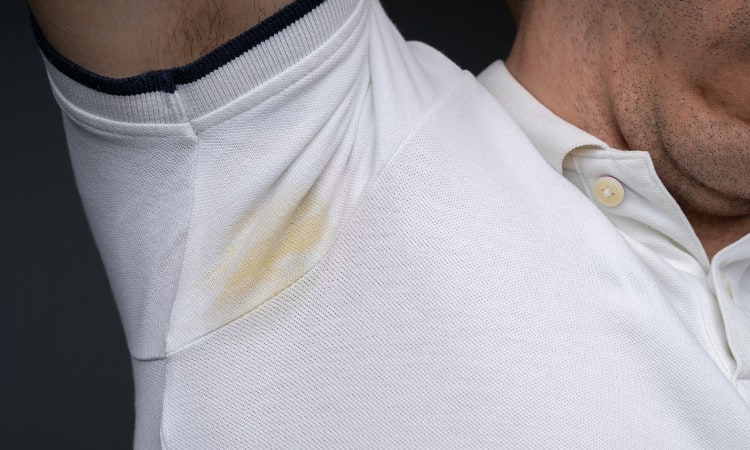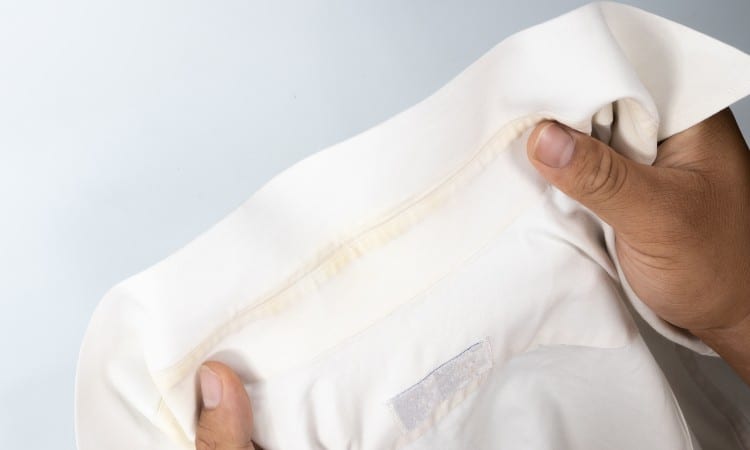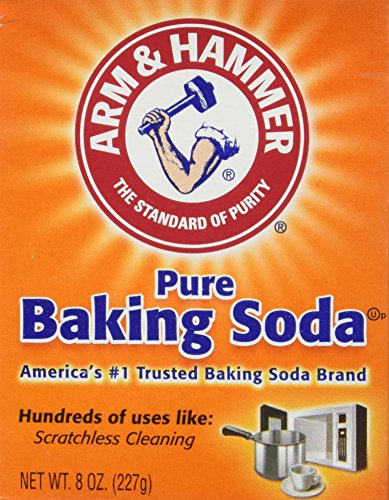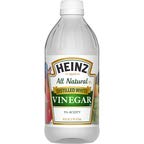I love wearing white shirts. They don’t stay white for long, though, do they? It doesn’t take long for yellow stains to start appearing in the armpit area. This leaves me with an important question. How to get yellow stains out of white shirts?
There are many ways to get yellow stains out of white shirts and they’re all suitable for home use. Vinegar, hydrogen peroxide, baking soda, and OxiClean are the most popular methods. Although it can be a tempting easy solution, never use bleach to remove yellow stains. It can make them worse.
Yellow stains on white shirts can be a real pain. Let’s take a look at what causes the stains and how to get rid of them. Read on to see if there are ways to stop the stains from appearing and ruining your best white shirt.

What Causes Yellow Stains on White Shirts?
Before we look at how to remove yellow stains from white shirts, we need to find out what causes them. The biggest contributing factor to those pesky marks is perspiration. Otherwise known as sweat.
Sweat is a mixture of water, salts, ammonia, and lactic acid. It’s a body fluid designed to reduce your temperature and stop you overheating. Once the mix is on the surface of the skin, it evaporates and takes the heat with it.
Sometimes, this sweat can’t evaporate and instead soaks into your clothing. Tight-fitting tops and fitted sleeves are instrumental in trapping sweat between your armpit and the fabric. Couple that with a non-breathable fabric like polyester; you’ve got a sweat trap.
Trapping perspiration between your body and your clothing causes visible wet patches, which dry to become stains. Over time, these stains increase, leading to the yellow marks we all know and hate.
The thing is, these stains can be found on any shade of clothing, not just white ones. Staining can be more obvious in lighter garments, but you’re just as likely to get stains on your blue shirt. Any clothing worn on your upper body can be subject to the dreaded armpit sweat.
Although your whole body is covered in pores capable of releasing moisture when you get too hot, nowhere collects perspiration in quite the same way as your armpit. It’s also the only part of your anatomy you routinely apply products to in an attempt to stop the sweat building up.
The reason we all use products on our underarms is simple. Sweat not only leaves unsightly marks on the underside of your shirtsleeves, but it also smells. It’s an unavoidable truth; armpits can cause some pungent body odor. A repugnant stink we’re all desperately trying to conceal.
Unfortunately, these products can exacerbate the problem. Adding a chemical deodorant or antiperspirant to your armpit may make your underarms smell fresh, but it also blocks your pores. By preventing the perspiration from leaving your pores, you’re allowing it to build up and mix with the chemicals in the product you are using.
Now, your armpits are a breeding ground for a sweaty gloop that acts as a petri dish for bacteria. The resulting smelly liquid seeps into the fabric of your clothing, leaving the infamous and unwelcome yellow stains.
How to Get Yellow Stains Out of White Shirts

All is not lost. There are ways to save your favorite white shirt from the fate of yellow stains. The good news is many solutions use items you probably already have. Here are some tried and tested methods you can easily try at home.
1 Hydrogen Peroxide, Baking soda, and Salt
 Both baking soda and salt are abrasive and ideal for scrubbing tough stains. Hydrogen Peroxide is a mild bleach, so make sure you only use this option on white clothing. Even mild bleach can strip the color out of the fabric.
Both baking soda and salt are abrasive and ideal for scrubbing tough stains. Hydrogen Peroxide is a mild bleach, so make sure you only use this option on white clothing. Even mild bleach can strip the color out of the fabric.
You will need:
- A mixing bowl
- An old toothbrush or a nail brush
- Cold water
- 1.5 teaspoons of salt
- 1.5 cups of baking soda
- 2 teaspoons of Hydrogen peroxide
- Mix the salt, Hydrogen Peroxide, and baking soda in the bowl. Stir the mixture until it forms a paste.
- Slightly dampen your shirt’s armpit area with a small amount of cold water. It only needs to be damp, so don’t add too much water.
- Apply the mixture to the armpit stains. Using the toothbrush, gently spread the mixture around, so it covers the stain. Allow standing for at least 30 minutes. You can also leave overnight for stubborn or worn-in stains.
- Scrub the stained area, working the mixture into the stain. Finally, rinse the garment. Wash it in your machine on a cold setting with your usual detergent and line dry.
2. Dish Soap, Hydrogen Peroxide, and Baking Soda
 Dish soap is fantastic at eating grease from crockery, pots, and pans. Because of this, it makes a brilliant ally in the fight against those nasty yellow marks. The reason is, it’s designed to break down enzymes, so it will work a treat on sweat.
Dish soap is fantastic at eating grease from crockery, pots, and pans. Because of this, it makes a brilliant ally in the fight against those nasty yellow marks. The reason is, it’s designed to break down enzymes, so it will work a treat on sweat.
This option uses Hydrogen Peroxide, so only use it on white shirts or tops. You may find the Hydrogen Peroxide will remove your garment’s color as well as the stain.
You will need:
- A mixing bowl
- An old toothbrush or a nail brush
- 1 cup of liquid dish soap, any brand
- 2 cups of Hydrogen Peroxide
- Small amount of Baking soda
- Cold water
- Mix the Hydrogen Peroxide and dish soap in the bowl. Stir until it is completely mixed.
- Using the toothbrush, apply the mixture to the stain. Sprinkle some of the baking soda on the top and gently spread it out, so it covers the entire stain.
- Allow to sit for at least an hour. You can leave it longer for stubborn stains.
- Rub the mixture around the stain in a circular motion. Rinse with cold water. Wash in your machine on a cold setting. Line dry for best results.
3. Hydrogen Peroxide and Water
You might find smaller yellow stains are easily removed by using a simple mix of Hydrogen Peroxide and water. As with the other Hydrogen Peroxide options, only use this method on white garments.
You will need:
- A mixing bowl
- 2 teaspoons of Hydrogen Peroxide
- 2 teaspoons of cold water
- Mix the water and Hydrogen Peroxide in the bowl. Make sure it’s completely mixed.
- Soak the garment in the mixture for a minimum of 45 minutes. Then, wash the garment in your machine on a cold setting. Check the garment before drying to make sure the stain has gone. If it hasn’t, repeat steps 1-2. When you are happy the stain has been removed, allow it to air dry.
4. Baking Soda and Water
So far, we’ve looked at remedies that combine baking soda with another cleaner. You don’t have to use it with anything else. It’s quite effective by itself.
You will need:
- A mixing bowl
- 1/4 cup of cold water
- 4 tablespoons of baking soda
- Mix the baking soda with the cup of water in the bowl. Make sure the baking soda is fully dissolved.
- Apply it to the stain and leave it to stand for at least an hour. Leave it a bit longer for tough stains.
- Wash the garment in your machine on a cold setting. Once the cycle is complete, check the stain. If it is still visible, repeat steps 1-3.
- Once you are happy the stain has gone, you can line dry the garment.
5. Vinegar and Water
 One of the unsung heroes in the kitchen, vinegar can be used for more than flavoring your food. You can also use it for stain removal.
One of the unsung heroes in the kitchen, vinegar can be used for more than flavoring your food. You can also use it for stain removal.
You will need:
- A spray bottle
- 1 cup of vinegar
- 1 cup of cold water
- Add the vinegar and water to the spray bottle and shake until the liquids are mixed.
- Spray the solution onto the stain and soak for at least an hour. Leave for longer on stubborn stains.
- Wash in your machine on a cold setting. If the stain is still visible, repeat steps 1-3. Once you are happy the stain is gone, air dry the garment.
6. OxiClean
 This one is a stain remover you can purchase. Specifically designed to combat stains and banish them from your clothing, OxiClean can be a useful tool in your laundry’s arsenal against stains in general, not just yellow ones. Check the instructions before using OxiClean on colored clothing.
This one is a stain remover you can purchase. Specifically designed to combat stains and banish them from your clothing, OxiClean can be a useful tool in your laundry’s arsenal against stains in general, not just yellow ones. Check the instructions before using OxiClean on colored clothing.
You will need:
- A tub or bucket
- 1 Scoop of OxiClean solution
- 1 gallon of warm water
- Mix the OxiClean and water in the tub or bucket. Make sure the OxiClean is fully dissolved.
- Push your white shirt into the bucket until it is completely covered by the water. Check the instructions on the packaging for details on how long to leave the garment to soak.
- Machine wash the garment as normal. Add an extra scoop of OxiClean to your clothing inside the drum. Once the wash cycle is complete, dry the garment as normal.
7. Toothpaste
Toothpaste probably wasn’t the first thing that came to mind for removing yellows stains. It removes them from teeth all the time. Best used on smaller areas, this one can be a quick fix for your stain problem.
You will need:
- Toothpaste
- A toothbrush
- Apply the toothpaste to the stain and brush with the toothbrush. Use a circular motion to rub the paste into the stain. Keep rubbing until the stain is removed.
- Wash the garment as normal. Dry in a dryer or naturally on a line.
8. Denture Tablets
This one works the same way as toothpaste. The main difference, this option can be used on larger areas. It does take slightly longer, though.
You will need:
- A bucket of cold water
- 4 denture tablets
- Add the denture tablets to the bucket of water and allow them to dissolve completely. Soak the stained garment overnight or for at least 12 hours.
- Wash the garment as you would normally. Dry in a dryer on your usual setting or air dry.
9. Lemon Juice and Water
Not only is lemon a great cleaner, but it also leaves behind a lovely aroma of citrus. This option is the first one to use hot water as part of the remedy.
You will need:
- A large heat-proof pot
- 3 lemons
- Water
- Slice the lemons. Use one of the slices to add lemon juice to the stained area of clothing. Put the clothing to one side. Put all the lemon slices in the pot.
- Fill the pot with water and bring to a boil. Once boiling, turn off the heat and add your clothing to the pot. Submerge it in the hot lemon water for around an hour. Before using this method, make sure the fabric can withstand heat.
- Wash the clothing as you would normally—either dry in a dryer or outside on a line.
10. White Aspirin
This one is one of the stranger things on the list. Aspirin is more widely known as a painkiller. Although colored aspirin pills are more likely to dye your garment, white aspirin has cleaning properties.
You will need:
- A bucket of cold water
- 5 white aspirin pills
- Make a soaking solution by dissolving the aspirin in the water. Add the clothing and let it soak for up to three hours.
- Wash the garment as you would normally. Dry in a dryer or out on a line.
11. Borax
 You can use Borax in two ways. Either as a pre-wash soak or in the drum of the machine with the washing. Borax is a bleach alternative and is safe to use on colored clothing.
You can use Borax in two ways. Either as a pre-wash soak or in the drum of the machine with the washing. Borax is a bleach alternative and is safe to use on colored clothing.
You will need:
- To pre-treat the yellow stain, add a teaspoon of Borax to a bucket of water and submerge the garment.
- Add 1/2 cup of Borax to the drum of your washing machine, so it is directly in contact with the clothing. Wash as normal on the usual settings. Once the cycle has completed, air dry or use a dryer.
How to Prevent Yellow Stains on White Shirts
One of the best ways to deal with yellow stains on white shirts is not to let them form in the first place. It sounds easier said than done, but it’s actually simple. All it takes is a little planning.
The most drastic of preventative methods is not to wear white shirts. This does narrow your wardrobe choices somewhat and can be annoying, especially if a white shirt is a work requirement. In a lot of cases, this one isn’t an option. Let’s take a look at some others.
Wearing an Undershirt
Years ago, when I was a child, my Mom would always go on about the need to wear a vest or some form of undershirt beneath my white shirt. It turns out she had a point. Wearing an undershirt helps stop yellow stains from forming on your best white tops.
As an undergarment, the vest or undershirt soaks up the sweat and deodorant mix before it has a chance to touch your prized overshirt. As no one sees your underwear, it doesn’t matter if they get stained.
It can be a little warm wearing more than one shirt, though. Another great way of preventing yellow stains on your white shirt is to wash it as soon as possible. Immediately after wearing is best but if that isn’t possible, make sure it’s the next day.
Change Your Deodorant
These days, antiperspirants and deodorants can be found with added stain prevention ingredients. So any yellow stains are neutralized before they can cause damage.
It does mean more chemicals are coming into contact with your body. But, at least your sweat doesn’t get the opportunity to soak into the fabric of your favorite shirt.
How to Keep White Clothes From Turning Yellow in Closet
If your white clothing is turning yellow when you store it, there could be a couple of things to blame. The first is the way you do the laundry.
Chlorine bleach is great for dealing with germs and it can help bleach clothes white. Using too much will turn your garments yellow. If you add bleach to your wash, make sure to add a spoonful of vinegar to the final rinse. That should help neutralize the bleach.
Another laundry-related issue is not using enough detergent or not rinsing the clothing properly. Not enough detergent will cause dirt and grime to get left behind. When your garment is stored, this can cause staining. Always follow the instructions on the packaging of your detergent to make sure you use the right amount.
If your clothing isn’t rinsed properly, soap residue could get left behind to coat the fibers of the fabric. One of the main causes is a cold water rinse on a water economy setting. The residue can cause the fabric to yellow over time. Fear not, it can be avoided. Use a laundry additive known as Bluing in the final rinse.
You may also find it isn’t storage that’s causing the yellowing. It could be the age of the garment. White garments come with built-in whitening agents from the dyes used to turn them white. These agents deteriorate with time causing clothing to turn yellowish. To prevent this one, add some whitening agent to your wash load.
The next cause of yellowing is your storage solution. Whatever you use, whether it’s plastic or wood, the chances are it’s either leaking by-products or out-gassing. These by-products are acidic and it’s the acid that causes clothing to turn yellow.
This one is a particular problem with antiques. So much so that you can now get special acid-free storage solutions to keep your clothing white. Mostly used by museums, these solutions keep fabrics safe from atmospheric contamination.
Things to Remember
Yellow stains in white clothing can be a pain, but it’s fixable if you act quickly. One of the first things you should remember is to steer clear of heat. Hot water or a hot dryer can set stains into fabric. This will make it twice as hard to remove them later.
Never use bleach to remove the yellow marks. Bleach can make stains worse, giving you an even bigger problem to solve. Whatever method you use to remove the yellow stains, always test a small area of the fabric first. You need to make sure the fabric can withstand the solution you intend to use. For instance, don’t use Hydrogen Peroxide with colored clothing.
Always act as fast as you can. White clothing should be washed as soon as you’ve worn it. Don’t give the sweat a chance to attach to your garment, and it will be easier to remove it in the wash.
Conclusion
Now you know what causes yellow stains on white clothing, it will be easier to prevent them from occurring. You’ll find it simpler to remove them if they do.
Let me know in the comments if you’ve had trouble with yellow stains. Have you tried any of the remedies mentioned in this article?